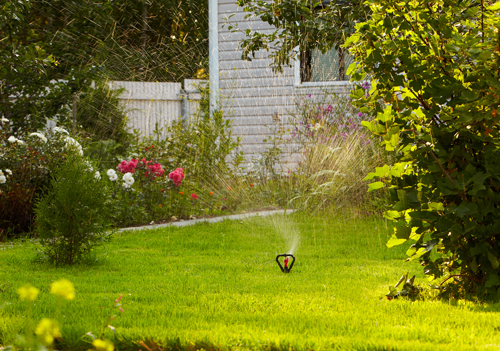Each spring at Frogs Are Green, we try to encourage people to create backyards (or gardens, if you’re English) that are friendly to wildlife and the environment, water-wise, and easy to maintain without using herbicides and pesticides.
Imitate Nature
It is possible to create a wildlife friendly garden without using pesticides and herbicides, but you’ll need to mimic nature a bit and do some detective work to find out what types of plants and flowers flourish in your area. Sometimes you don’t even need to plant these natives—they may migrate to your backyard, and if you like them, you can find a place for them. This happened with me—a native fern migrated over to my yard and it is quite beautiful. Over the years, the ferns have spread and make a nice ground cover. That doesn’t mean you need to restrict yourself to native plants. My New Guinea impatiens obviously are not native to New Jersey, but I definitely try to fit in a number of low-maintenance native plants.
In my first years of gardening, I had to water my backyard every day with a hose to keep it alive. Now with a backyard filled with lots of native plants, I only water the potted plants.
Survival of the Fittest
After several years, I’ve realized that I can’t plant hostas—they’re like candy to slugs. Rather than spend money and effort, and possibly introduce toxins to the soil, to get rid of the slugs, I now keep the hostas in pots, above the ground, and then periodically lift the pots to check for any slugs. (Yes, I tried the tuna can full of beer method to get rid of slugs, but they didn’t fall for that trick.)
Since I don’t have much sun in my urban backyard, I don’t plant sun-loving annuals anymore. These flowers didn’t flourish and so seemed to attract disease and bugs. Have you tried some flowers that didn’t quite make it, or if they did, required a lot of watering or pesticides to maintain them? You may have found that other plants just seem to do great year after year without much attention. In my garden, potted geraniums seem to do well, lasting all the way through until frost, even without a lot of sun or attention. Even though they’re not the most exotic flowers, I have lots of them in interesting colors.

KEEP THE ANIMALS HAPPY
I put out seed for the birds, although around this time of year in late spring, I start to cut down on bird seed. I put out water for them in a bird bath as well, and I sometimes also notice bees dipping into the bird bath. Because I don’t use herbicides or pesticides, I am not unintentionally killing off good insects—bees, lady bugs, etc. or potentially harming other animals like songbirds.
Build a Frog Pond
We don’t have any amphibians in my city (that I know of), but if you have amphibians in your area, put out a toad abode to keep these local insect-eating amphibians happy.
It’s also possible to create a frog pond relatively easily without a huge expense or effort. My sister put in a frog pond by her house in Connecticut, and on one summer day, she counted eighteen frogs enjoying her pond, including one frog who jumped up and sat right beside her on the garden bench. Here’s how she did it:
She dug out a base that was 4 feet by 7 feet, about 2 feet deep. On each corner, she created a shelf, 1 foot deep, for aquatic plants.
She bought pond liner from a garden center, a piece larger than the pond (so it was 12 feet long by 9 feet wide) and put stones down to hold it in place. She also piled smaller stones in one corner that came just above the water as a ramp for the frogs to get in and out of the pond.
She also added water flowers with leaves and lily pads. These plants act as filters for the pond (and, of course, our froggy friends like to sit on them).
She put in a pump to circulate the water (with an outdoor extension cord buried in ground to house).
She notes that the pond should be cleaned out every year. Take out the water, but be careful if there are frogs eggs in the pond. Put the eggs in a clean bowl with pond water before putting back in the pond. Also, she did not add the frogs to the pond—they migrated to her pond from another small pond on her property. Don’t introduce non-native frogs to your pond as they could disrupt the local ecology and introduce disease to native frogs
Please send us your ideas for creating a natural backyard and if you have some pictures, send them along and we’ll add them to our backyard gallery (see the photo gallery in our sidebar to the right).
Here is more information about your having your backyard certified as a Wildlife Habitat by the National Wildlife Federation.












